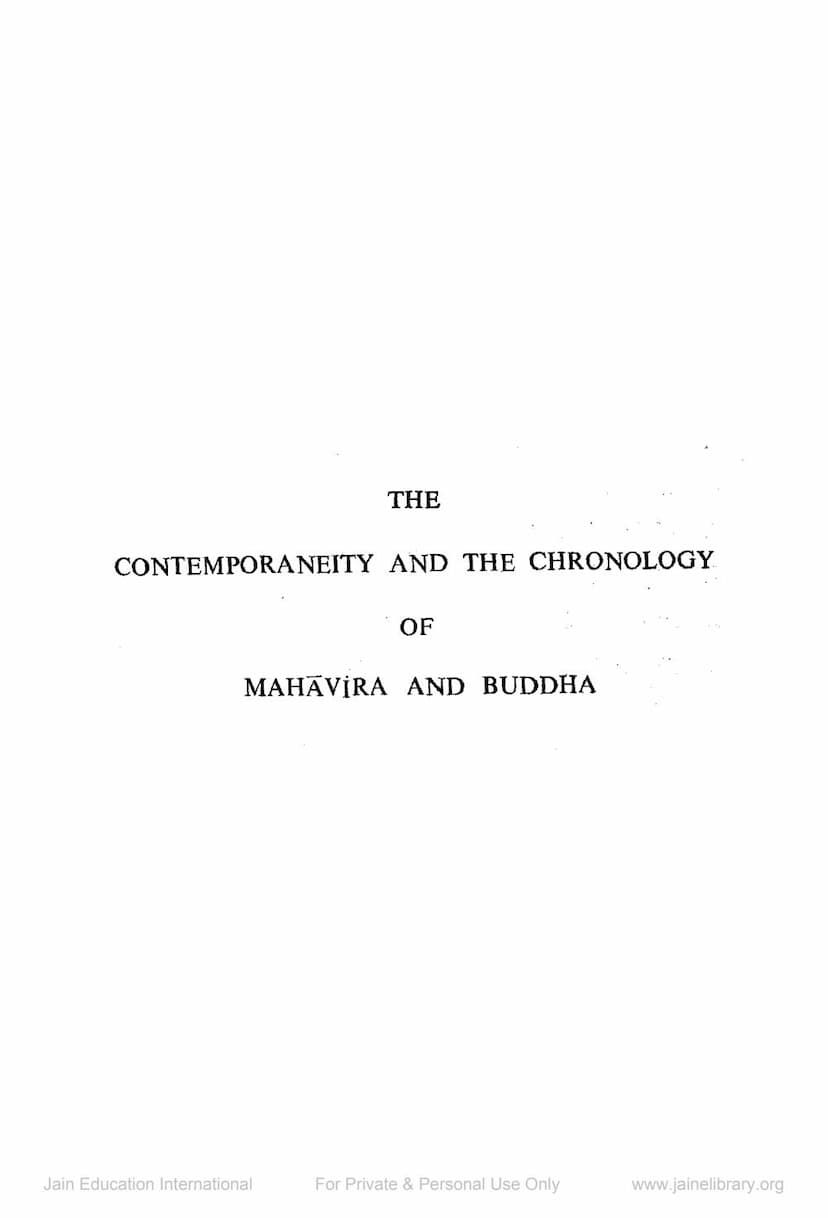Contemporaneity And Chronology Of Mahavira And Buddha
Added to library: September 1, 2025

Summary
Here is a comprehensive summary of the Jain text "Contemporaneity and Chronology of Mahavira and Buddha" by Nagrajmuni, translated and edited by Mahendramuni:
This book is a scholarly exploration into the historical timeline and the period of shared existence of two pivotal figures in Indian religious history: Mahavira, the 24th Tirthankara of Jainism, and Gautama Buddha, the founder of Buddhism. The author, Muni Shri Nagrajji, embarks on a detailed examination of various theories and evidence presented by both Indian and Western scholars, aiming to establish a more precise chronological framework for their lives and teachings.
The core problem addressed is the uncertainty surrounding the exact birth and death dates of Mahavira and Buddha, and consequently, the extent of their contemporaneity and their relative seniority. The book acknowledges the challenges posed by the nature of historical sources available for this period, which often rely heavily on religious scriptures, literature, and epigraphic evidence, often lacking the precision of modern historical records.
Key Arguments and Analyses Presented in the Book:
-
Critique of Existing Theories: The book systematically reviews and critically analyzes the various viewpoints put forth by prominent scholars, including Dr. Hermann Jacobi, Dr. Jarl Charpentier, Dr. K.P. Jayaswal, Dr. Radha Kumud Mukherjee, Muni Kalyana Vijayaji, and others. It highlights the contradictions and inconsistencies found in their conclusions, particularly concerning the dates of Nirvana and the interpretation of scriptural evidence.
-
Emphasis on Jain and Buddhist Canonical Literature: A central theme is the author's rigorous examination of the Jain Āgamas and the Buddhist Tripitakas. Nagrajji argues that these primary canonical texts hold the most reliable evidence, and that previous scholarly attempts have sometimes overlooked or misinterpreted crucial passages.
-
Mahavira's Seniority: A significant conclusion of the book is that Mahavira was senior to Buddha. This is supported by:
- Analysis of Buddhist Tripitakas: The author draws attention to specific passages in Buddhist scriptures that refer to Mahavira's death and the subsequent disputes among his followers, suggesting that Buddha received this news during his lifetime. He also points to instances where Buddha, by implication, acknowledges his juniority to Mahavira and other contemporary religious leaders in terms of age, knowledge, and period of renunciation.
- Jain Āgamas and historical context: The book delves into the details of events described in Jain scriptures, such as the wars involving Ajatasatru (Konika), and argues that these events, as recorded in Jain texts, align with Mahavira's timeline and imply his seniority. The author also refutes the argument that more extensive Jain accounts of contemporary events necessarily imply Mahavira's survival of Buddha.
-
Chronological Reconstruction:
- Mahavira's Chronology: The author asserts that 527 B.C. is a well-established and relatively uncontroversial date for Mahavira's Nirvana. This date is corroborated by various sources, including Jain traditional works that link Mahavira's Nirvana to the accession of Chandragupta Maurya and the commencement of the Vikrama and Saka eras. Astrological calculations and traditional Jain eras are also presented as supporting evidence.
- Buddha's Chronology: In contrast, the book notes the greater ambiguity surrounding Buddha's chronology, with various dates proposed by scholars and traditions. By cross-referencing Mahavira's established timeline with events described in Buddhist scriptures, particularly concerning the reign of Ajatasatru and Buddha's life stages, Nagrajji proposes a date of 502 B.C. for Buddha's Nirvana.
- Period of Contemporaneity: Based on these established dates, the book calculates that Mahavira and Buddha lived contemporarily for approximately 55 years, with their active religious leadership overlapping for about 20 years.
-
Critique of Ceylonese Chronicles: The book expresses skepticism towards the reliance on Ceylonese chronicles like the Mahavamsa for early Indian chronology. It points out significant discrepancies between these chronicles and Indian sources (Purāṇic and Jain), suggesting inaccuracies and potential biases, particularly in their dating of events related to Mahavira and Buddha.
-
Corroboration from Various Traditions: The author seeks to strengthen his conclusions by presenting corroborating evidence from:
- Tibetan Tradition: Similarities in the relative timelines of Buddha's life events and the reign of King Pradyota are noted.
- Chinese Turkestan Tradition: The proposed dates are found to be largely consistent with traditions from this region.
- Ashoka's Edicts: The author analyzes inscriptions from Emperor Ashoka, particularly the Minor Rock Edicts, which mention a date 256 years after Buddha's Nirvana. By cross-referencing with Ashoka's consecration date, this evidence is interpreted as supporting Buddha's Nirvana around 502 B.C.
- Burmese Tradition: The "Eetzana era" in Burma provides traditional dates for Buddha's life events that align closely with the author's deductions.
-
Key Findings about their Relationship:
- Mahavira was older than Buddha (by approximately 17 years according to the book's final calculation).
- Mahavira passed away earlier than Buddha (by approximately 25 years).
- Mahavira had achieved significant fame and influence in the religious sphere before Buddha's enlightenment.
In essence, "Contemporaneity and Chronology of Mahavira and Buddha" presents a meticulously researched argument that challenges some prevailing scholarly views. It advocates for a revised timeline that places Mahavira as a senior contemporary of Buddha, offering a comprehensive analysis of scriptural evidence, historical records, and traditional accounts to support its conclusions. The book aims to provide a more accurate historical understanding of these two foundational figures of Indian spirituality.